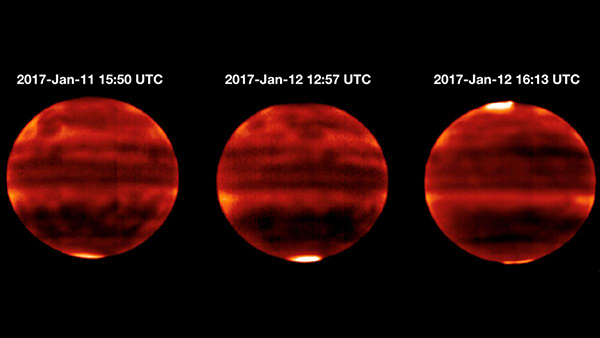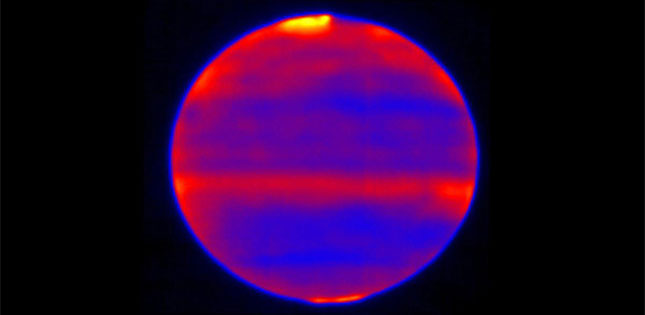An international team comprising the NASA Jet Propulsion Laboratory (JPL), Tohoku University and National Institute of Information and Communications Technology (NICT), has discovered that the solar wind-driven high-energy phenomena known as the Jovian aurora, is heating Jupiter's atmosphere to a deeper level than previously thought.
They made the discovery using the mid-infrared camera COMICS on the Subaru 8-m telescope operated by the National Astronomical Observatory Japan (NAOJ) at the summit of Mauna Kea in Hawaii.
Mid-infrared images of Jovian were taken in January, February and May 2017, and the team captured the emission area "hot spots" of methane gas in the polar region of Jupiter.

On Earth, auroras occur when energetic particles blown out from the sun interact and heat up the gases in the upper atmosphere. On Jupiter, a similar process happens, but the solar wind appears to have a more direct effect on the deeper stratosphere where methane gas is present. This suggests that the organic chemical reactions and heating in deeper atmospheres where methane is present can be directly caused by energetic particles precipitating from space.
"The impact at Jupiter is an extreme example of space weather," said James Sinclair of NASA JPL, who led the research. "We're seeing the solar winds having an effect deeper than is normally seen."
"What is startling about the results is that we were able to associate for the first time the variations in solar wind and the response in the stratosphere, and that the response to these variations is so quick," said Glenn Orton, also from NASA JPL.
"The result shows that high energy particles from space can directly affect the heating and chemical reactions in Jupiter's deeper atmosphere. Such a process could be seen more with planets with a harsh environment exposed to strong stellar activities, such as our Earth in its younger days and exoplanet around active stars," said Professor Yasumasa Kasaba from the Planetary Plasma and Atmospheric Research Center (PPARC) at Tohoku University.
"This new information gives a clue to the complex organic chemical reactions in the atmosphere of such planets." Kasaba is a co-author and principal researcher of the Subaru observation team.
PPARC operates its own radio and visible-infrared telescopes around Sendai and Haleakala, Maui island in Hawaii. It contributes to the Hisaki ultraviolet space telescope operated by the Japan Aerospace Exploration Agency (JAXA), as a part of this international Jupiter observation campaign. These Subaru observation results are linked to those activities.
- Publication Details:
Title: A brightening of Jupiter's auroral 7.8-micron CH4 emission during a solar-wind compression
Authors: J. A. Sinclair, G. S. Orton, J. Fernandes, Y. Kasaba, T. M. Sato, T. Fujiyoshi, C. Tao, M. F. Vogt, D. Grodent, B. Bonfond, J. I. Moses, T. K. Greathouse, W. Dunn, R. S. Giles, F. Tabataba-Vakili, L. N. Fletcher & P. G. J. Irwin
Journal: Nature Astronomy
DOI: 10.1038/s41550-019-0743-x
Link:
Contact:
Yasumasa Kasaba
Planetary Plasma and Atmospheric Research Center,
Graduate School of Science,Tohoku University
Email: kasaba pparc.gp.tohoku.ac.jp
pparc.gp.tohoku.ac.jp
Website: http://pparc.gp.tohoku.ac.jp/index-en.html


